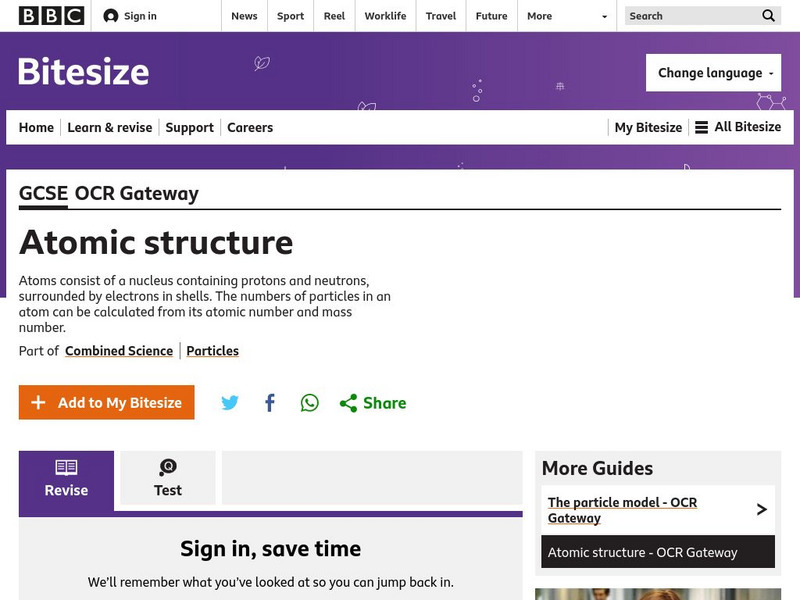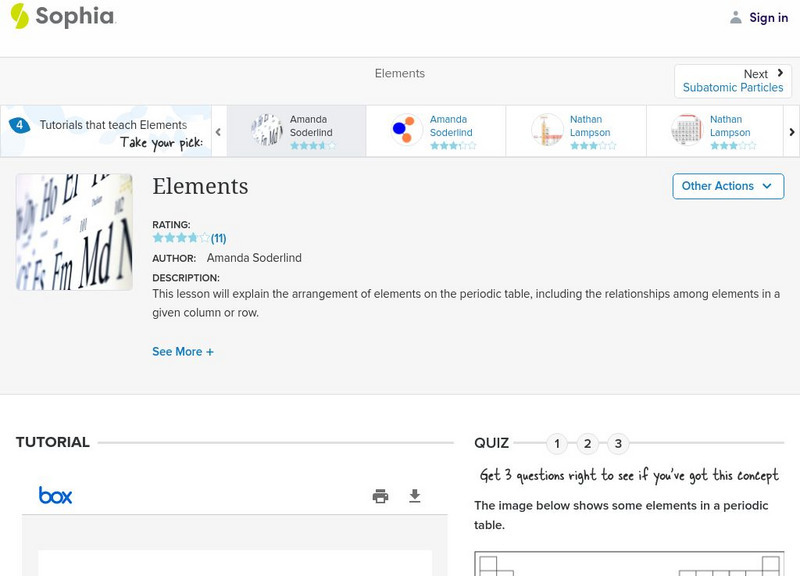Chem4kids
Chem4 Kids: Atoms Are Building Blocks
Identify the basic structure of atoms, the building blocks for all matter.
Physics Classroom
The Physics Classroom: The Strucure of Matter
This interactive tutorial begins with an understanding of the structure of matter. Understanding charge as a fundamental quantity demands that we have an understanding of the structure of an atom. Learn the atomic structure of an atom an...
BBC
Bbc: Gcse Bitesize: Atomic Structure
This lesson focuses on the structure of atoms. All substances are made from atoms. Each atom is made of a nucleus - containing protons and neutrons - surrounded by electrons. It provides a link to an assessment.
Chiral Publishing
Chiral Publishing: An Introduction to Chemistry: The Structure of the Elements
A beginner's lesson to the structure of the elements. Quiz yourself on the basics of atomic structure for some of the common elements.
California State University
Csudh Project for Chemistry: Protons, Electrons, and Neutrons
This page is an exercise in relating the number of protons, electrons, and neutrons for an atom or monoatomic ion.
Chem Tutor
Chem Tutor: Atomic Structure: Atomic Weights and Atomic Numbers
This lesson explains many basic concepts of atomic structure. It starts with atomic mass and number and then works up to more sophisticated information on electron configuration and how each element fits into the Periodic Table.
CK-12 Foundation
Ck 12: Chemistry Simulation: Rutherford's Gold Foil Experiment
[Free Registration/Login Required] How can we predict an atom's structure, if we cannot see an atom? Using the Rutherford's Gold Foil Experiment, make your own model and test out the model.
CK-12 Foundation
Ck 12: Physical Science for Middle School
This digital textbook covers core physical science concepts and includes interactive features, real world examples, and videos.
CK-12 Foundation
Ck 12: Chemistry for High School
This digital textbook covers core chemistry concepts and includes interactive features, real-world examples, and videos.
Concord Consortium
Concord Consortium: How Does an Object Become Charged?
Activity 2 in this module examines How do objects become charged? An investigation of where the electrons come from and where they go, when atoms become charged.
Concord Consortium
Concord Consortium: What Is Happening When a Spark Occurs?
Students define potential and kinetic energy, explore energy transfer and energy conservation, and connect energy to atomic structure. The following activities guide students to a conclusion: Activity 1. Can my finger start a fire?...
Concord Consortium
Concord Consortium: What Are Nature's Building Blocks?
Activity 1 of this module explores What are the particles that make up all substances, and how small are they? A history of the atom is included.
Concord Consortium
Concord Consortium: Where Does All the Energy in an Explosion Come From?
In this module Activity 2 investigates What happens to atoms during a chemical reaction? In this activity students explore chemical reactions and develop a model to explain observations of chemical reactions.
Concord Consortium
Concord Consortium: Where Does All the Energy in an Explosion Come From?
Students construct a model of chemical reactions involving energy and electrostatic interactions and compare reactions and changes in energy through the following activities. Activity 1 What energy changes occur during an explosion?...
Concord Consortium
Concord Consortium: How Can a Small Spark Start a Huge Explosion?
In this module Activity 4 investigates How are bonds formed and broken? This activity explores the relationship between energy and the formation and breaking bonds, using the ideas of energy transfer and conversion.
Concord Consortium
Concord Consortium: How Can a Small Spark Start a Huge Explosion?
In this module Activity 3 investigates When atoms get close to each other, what happens to their potential energy? This activity applies energy concepts to compare the potential energy of atoms that are bonded as molecules with the...
Concord Consortium
Concord Consortium: What Makes Water Special?
In Activity 1 investigates How are water and other liquids similar and different? The student will see if ideas involving energy, electrostatic interactions, and atomic structure, can be used to explain why a hurricane is so powerful.
CK-12 Foundation
Ck 12: Earth Science: Atoms to Molecules Study Guide
Understand the basic structure of atoms and molecules in the Earth's crust.
Museum of Science
The Atom's Family: The Phantom's Portrait Parlor
In this activity, students investigate the atomic world by attempting to reduce paper to the size of an atom. Although students won't be able to cut the paper that small, they will gain a better understanding of how small the atom is.
Quia
Quia: Mr. Snyder's Game of Atomic Terms
A short matching quiz on basic terminology related to atomic structure. Answers provided.
Sophia Learning
Sophia: Elements: Lesson 4
This lesson will explain the arrangement of elements on the periodic table, including the relationships among elements in a given column or row. It is 4 of 4 in the series titled "Elements."
Sophia Learning
Sophia: Elements: Lesson 1
This lesson will explain the arrangement of elements on the periodic table, including the relationships among elements in a given column or row. It is 1 of 4 in the series titled "Elements."
Sophia Learning
Sophia: Elements: Lesson 2
This lesson will explain the arrangement of elements on the periodic table, including the relationships among elements in a given column or row. It is 2 of 4 in the series titled "Elements."
ClassFlow
Class Flow: Nitrogen
[Free Registration/Login Required] In this flipchart, students are introduced to the element nitrogen, its gaseous state, atomic structure, and how it combines with hydrogen to form ammonia.










